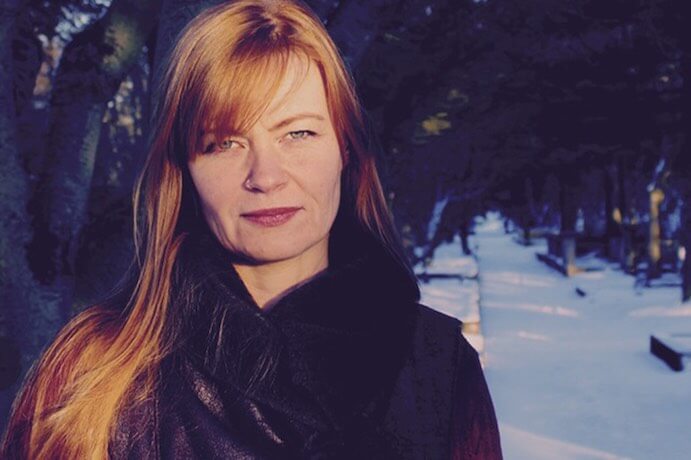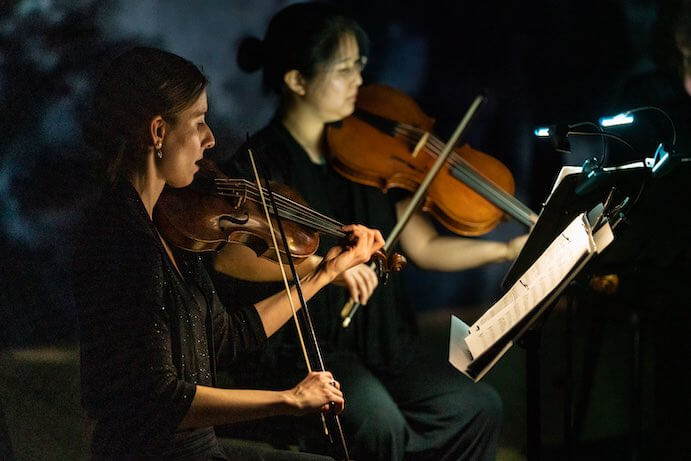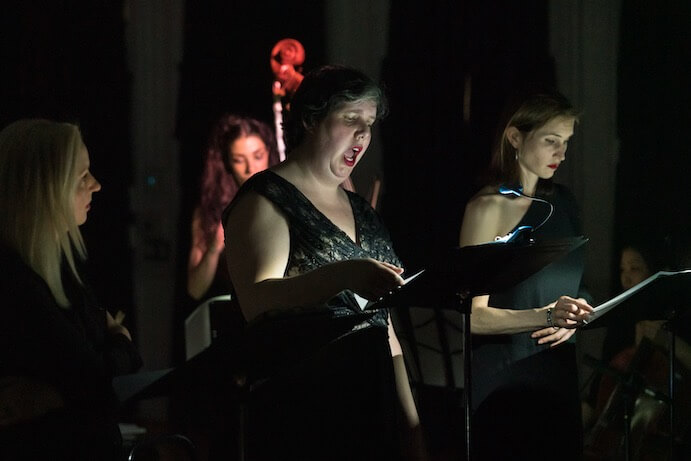Bló∂hófnir (Bloodhoof) is an incredible tale that provokes burning ambivalence. Presented by MATA and the PEN World Voices Festival at University Settlement’s Speyer Hall on May 11th, 2019, this lightly textured music and glacially dense libretto introduce us to the blurred interior and exterior worlds, complicated family relationships, and beloved homeland inhabited by a complete feminine force. Her expansive loves and violent losses expose the intergenerational experience of women throughout history.
Composer Kristín þóra Haraldsdóttir was originally commissioned to write a work of 12-20 minutes, but she rightly realized Ger∂ur Kristný’s poetry required a larger vehicle. Because the commissioning ensemble provided the instrumentation, the bulk of Kristín’s work was textual. She translated Ger∂ur’s poem into an unassumingly wrenching through-composed work, narrated in first-person by Sara Couden as the giantess and accompanied by mezzo-sopranos Augusta Caso and Tynan Davis, with the Friends of MATA ensemble on period baroque instruments. Kristín structured an hour in five divisions: memory, homeland and incoming threat, goodbyes and nine nights of grief, arrival to violence, and going away.
In both the classic Eddic poem “Skírnismál” (The “Lay of Skírnir”) and Bló∂hófnir, a male god falls in love with a foreign female giantess. He sends a messenger with symbols of wealth and power to secure marriage, but the giantess is unmoved by any promises of material gain and refuses repeatedly. Only when she and her family are threatened does she unwillingly go to the foreign god, enduring at least one night that produces a son. Ger∂ur Kristný has been aware of this story since childhood–the giantess, Ger∂ur Gymisdóttir, is her namesake–but as an adult, she noted the sexual violence in what was typically a celebrated romantic story. Although no particular event provoked Ger∂ur to write the poem, she witnessed the growing movement of women telling or reframing their stories and was inspired to contribute her highly recognized installment. Ger∂ur’s use of the non-human female to interrogate these topics brings to mind Cécile McLorin Salvant’s recent original song cycle Ogresse.

Composer Kristín þóra Haraldsdóttir–Photo by Tinna Kristjánsdóttir
The poetry demands that the music function as both a beloved external landscape and the giantess’ interior world, a challenge Kristín conquered by layering graceful musical wisps that belied their collective gravity. The lighter timbre of baroque instruments, including harmonium and harp with gut strings, augmented the weight of Sara Couden’s unending contralto narration. Breezy muzak entwined with Baroque intervallic leaps, unusual resolutions, and colored pitches that hearkened troubadourial traditions and disjunct time. Subtle highlights of each instrument varied the ensemble texture and characterized a group without percussion (Dara Bloom on baroque contrabass was the anchor and engine when rhythmic surges were demanded). Kristín says she composed confidently without self-censure and enjoyed that process, especially being able to utilize word painting. She cinematized the poetry with angry hiss tremolos, plucked string horse gallops, and after the giantess is raped (she collects pieces of her body from around the room and “puts her eyebrows back on”), the harp gently supports her dissociated recovery.
Ger∂ur and Kristín’s work endeared the giantess to me, with her deep love for homeland and kin. I was angered that this innocent, free spirit was preyed upon, but also confused why events unfolded as they did. Her father is said to be feared throughout the land as king, and the jewelry she wears as tokens of his affection make her disinterested in any foreign wealth. Where is the beloved father when she believes she must sacrifice herself to protect her family? One vague line said that he rejoiced at her new life, which seems to be a gross misunderstanding or relational betrayal, but he is otherwise absent. The giantess tells her mother of the “proposal,” but despite being described as anchored in the home life and emotionally intuitive, the mother seems to helplessly allow Ger∂ur’s terrified decisions. Why does the mother permit the trafficking? Perhaps the mother lacked influence in family governance or the strength to resist patriarchal practice; although this also felt like a gross betrayal, the giantess remains devoted and poignantly reliant upon her mother for the rest of her life.

Blo∂hofnír at MATA Festival 2019–Photo by Steven Pisano
In my attachment to the giantess, I wanted an explanation or a person to blame for what was happening. Ironically, the lack of male perspectives in this piece isolates the women. It was clear that Ger∂ur was the victim, her best qualities preyed upon to her ultimate destruction, but I found myself blaming her for what seemed like unnecessary decisions, and I struggled to focus on what I know to be true of women’s historical vulnerability. I was determined from the outset to believe the giantess, and therefore surprised by the intensity of my struggle to support her. Like my personal experience, audience responses at a pre-concert talk were also conflicted. One audience member welcomed the power of new voices and the potential for all our narratives to be heard afresh. Another participant challenged the work’s perspective, feeling that historical context was being misrepresented in service of a modern goal. Given its cocktail of musically unobscured, potent content and its capability to generate intense reactions, this piece merits a regular post-concert discussion in local settings.
Kristín felt the special dynamic of an all-women creative team imbued the project with the “power of the joined feminine force,” and she was left with a heightened awareness of solidarity. Credit is due to MATA for continuing to present singular and necessary programming. They gave attention to a beautiful, expert work that will continue to forge a future for itself.























